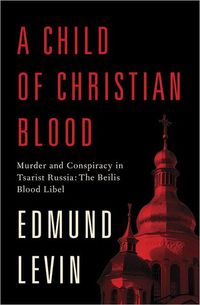

Purchase
A Child Of Christian Blood
Edmund Levin
Murder and Conspiracy in Tsarist Russia: The Beilis Blood Libel
Schocken
March 2014
On Sale: February 25, 2014
400 pages
ISBN: 0805242996
EAN: 9780805242997
Kindle: B00EX4FFLI
Hardcover / e-Book
Add to Wish List
Non-Fiction | Non-Fiction History
A Jewish factory worker is falsely accused of ritually
murdering a Christian boy in Russia in 1911, and his trial
becomes an international cause célèbre.
On
March 20, 1911, thirteen-year-old Andrei Yushchinsky was
found stabbed to death in a cave on the outskirts of Kiev.
Four months later, Russian police arrested Mendel Beilis, a
thirty-seven-year-old father of five who worked as a clerk
in a brick factory nearby, and charged him not only with
Andrei’s murder but also with the Jewish ritual murder of a
Christian child. Despite the fact that there was no evidence
linking him to the crime, that he had a solid alibi, and
that his main accuser was a professional criminal who was
herself under suspicion for the murder, Beilis was
imprisoned for more than two years before being brought to
trial. As a handful of Russian officials and journalists
diligently searched for the real killer, the rabid
anti-Semites known as the Black Hundreds whipped into a
frenzy men and women throughout the Russian Empire who
firmly believed that this was only the latest example of
centuries of Jewish ritual murder of Christian children—the
age-old blood libel.
With the full backing of
Tsar Nicholas II’s teetering government, the prosecution
called an array of “expert witnesses”—pathologists, a
theologian, a psychological profiler—whose laughably
incompetent testimony horrified liberal Russians and brought
to Beilis’s side an array of international supporters who
included Thomas Mann, H. G. Wells, Anatole France, Arthur
Conan Doyle, the archbishop of Canterbury, and Jane Addams.
The jury’s split verdict allowed both sides to claim
victory: they agreed with the prosecution’s description of
the wounds on the boy’s body—a description that was worded
to imply a ritual murder—but they determined that Beilis was
not the murderer. After the fall of the Romanovs in 1917, a
renewed effort to find Andrei’s killer was not successful;
in recent years his grave has become a pilgrimage site for
those convinced that the boy was murdered by a Jew so that
his blood could be used in making Passover matzo. Visitors
today will find it covered with flowers.
Comments
No comments posted.
Registered users may leave comments.
Log in or register now!
| 


 © 2003-2025 off-the-edge.net
all rights reserved Privacy Policy
© 2003-2025 off-the-edge.net
all rights reserved Privacy Policy